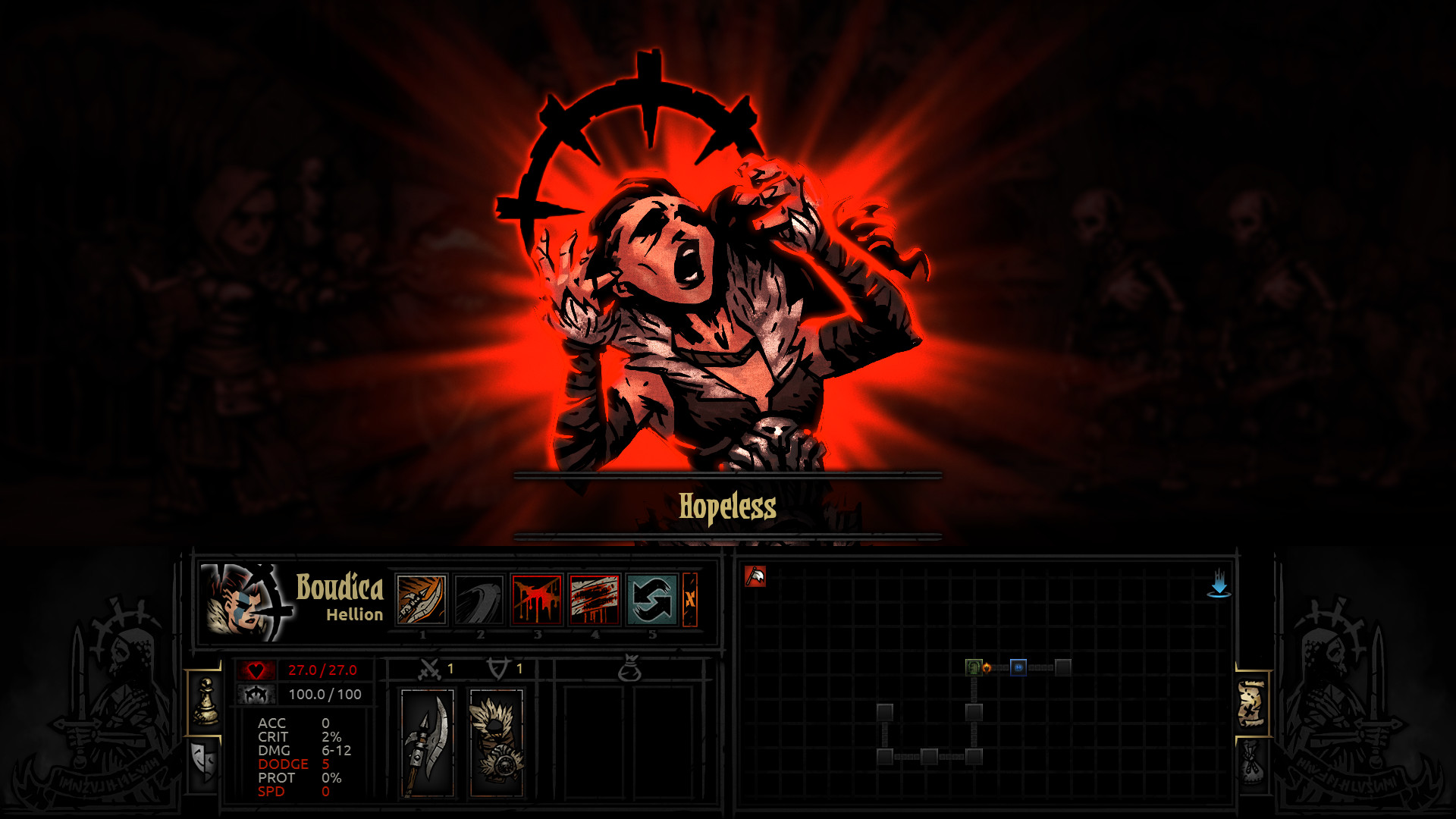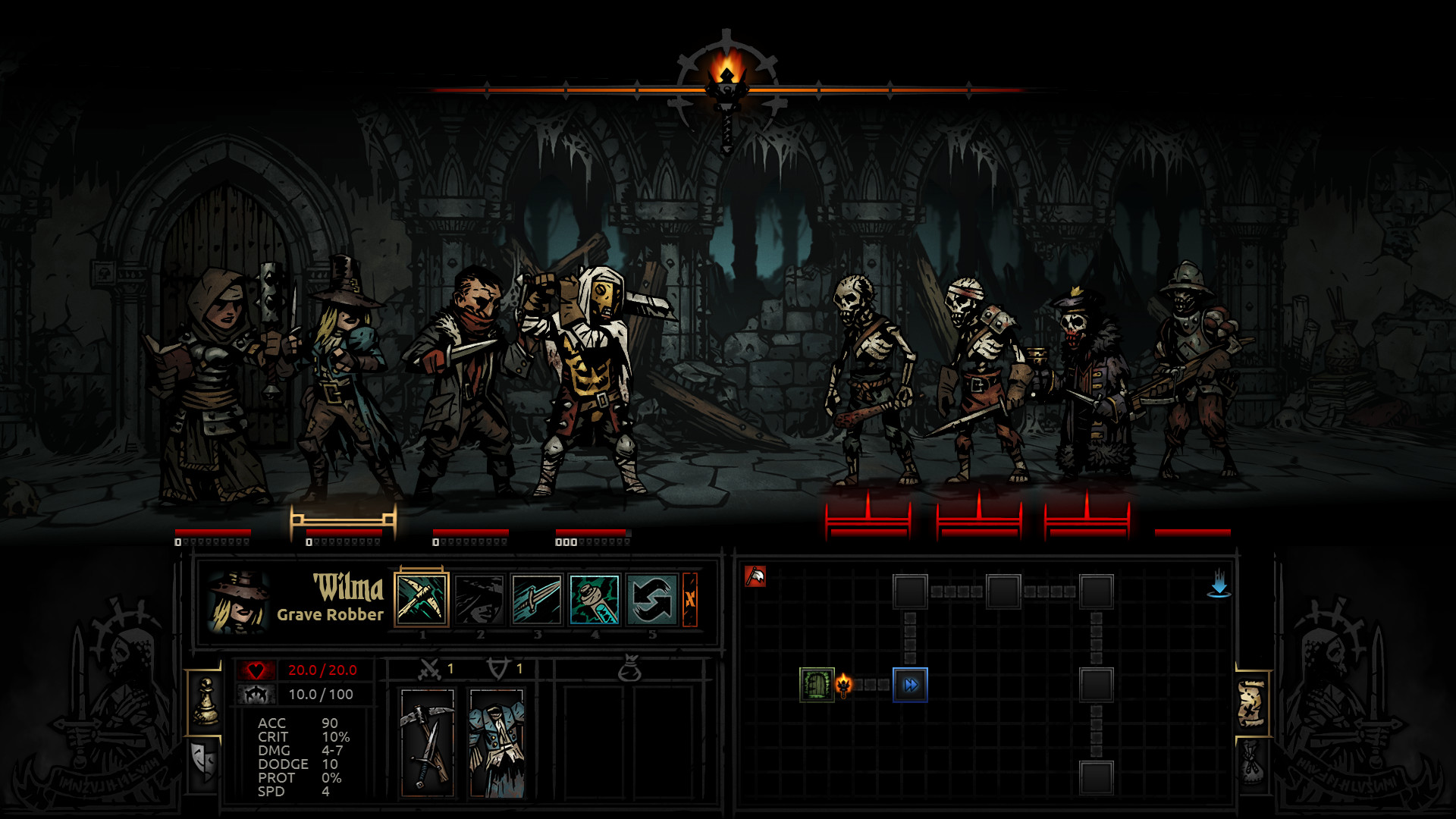It entered the crowdfunding realm on March 14, 2014. It covered its $75,000 goal in less than 24 hours. A year later, it was seen regularly on Twitch.tv’s top 10 streamed games despite only being in the infancy of its Early Access life cycle. No, this is totally not a cheesy intro to an article, but merely a list of facts applying to Darkest Dungeon – an astoundingly evil and mind-bogglingly fun dungeon crawler that will surely make you rip your hair in frustration.
I get the shivers just by saying the name actually, thinking about the swine monsters, the drums (the stressful type, imagine that), the necromancy, the heart attacks, the corpses and all those awful diseases I’ve never heard of before… And yet, Darkest Dungeon manages to lure me into playing more and more each day, as if I’m some sort of sadist addicted on torture and despair. I guess it also helps that I’m a sucker for highly stylized visuals, especially ones depicting dank dark dungeons narrated by the most perfidious narrator you’ll ever have the pleasure to listen to.
However, if you’ve come for a review I’m afraid this is the wrong place. Instead, wouldn’t it be better if we took a returning glimpse at the original Kickstarter campaign, how it all lead into Early Access and what the current (final) state of the game is in relation to the original pitch?
Yeah, that sounds like a great idea. Let’s get cracking.
Ultimately, Darkest Dungeon was officially released on January 19, 2016 – nearly 2 years after its Kickstarter launch, with the last 11 months spent in Early Access. This release also surprisingly appears to be on time, with a previous update stating mid to late 2015 as a launch window (PS4 and PS Vita versions coming in Spring 2016). Indeed, a rather rare occurrence for an age riddled with delays and mismanagement. More importantly though, the project was funded in less than a day (ultimately achieving the impressive sum of $313,337), with all of this essentially covering almost every single planned stretch goal.
So, how many of those ended up in the final game? Let’s take a look.
- Houndmaster class ($90,000) – check;
- Brigands ($100,000) – check;
- Multiple random Boss variants ($125,000) – check (although somewhat lazily implemented);
- Town activities & new shops ($150,000) – check;
- 2 New Character Classes & additional quest types – we are still waiting for the Merchant class, which is confirmed to be a free update sometime in the near future);
- New dungeon, monster set & curios ($200,000) – check;
- Town Events ($250,000) – again, expected to come as a free post-launch update;
- Ancestor’s Trinket Pack ($285,000) – check;
- Character color customization ($300,000) – check;
With 2 out of 9 stretch goals being delivered in the final release and the remaining ones planned as free updates, there isn’t really much to complain about. I also want to note that the list above is a prime example of stretch goals done right – no over-the-top craziness written down just for the sake of generating income, but doable and logical features that would greatly enhance the game in general.
Looking more closely at the state of Darkest Dungeon’s Kickstarter page, there were a total of 20 updates between the period of the game’s initial funding and its eventual release, with this period spanning almost 2 years. Sure, it’s not a huge number, but then again most discussion has been happening over at Red Hook’s forums, especially when it comes to Early Access testing. Perhaps the most important thing to mention is that when looking back at images and videos from February 2014 it’s very hard to spot huge differences in relation to what we have now. In other words, Darkest Dungeon looked amazing even when it was first unveiled to the public, this arguably being the reason as to why the game garnered so much success and attention in the first place.
Don’t believe me? Just take a look at the first ever public footage of the game in action:
Flashy effects and camera sways aside, it’s all pretty much identical. And that’s great, because all the developers had to do was add more content. That, and lots (sorry, I mean LOTS) of balancing. Which brings us to the topic of Early Access.
Was it beneficial? As with most games employing this way of development, it definitely hasn’t been a road without bumps. I remember reading an article by Jim Sterling a few months back, with the piece exposing Darkest Dungeon’s shaky Early Access state at the time by pointing out all the negative reviews flooding the game’s Steam page, those mostly targeted towards questionable design decisions making the game either “too hardcore” or “too random”. As of now, the situation is surprisingly similar, although complaints seem to be leaning more towards the latter opinion.
I’d like to think that most negative reviews are the result of people rage-quitting in utter frustration after getting their precious party wiped, but then again it would also be beneficial to recognize the biggest changes implemented during Darkest Dungeon’s 11 month-long Early Access stay.
First on the list are corpses. The dreaded corpses. Perhaps the most controversial change introduced by the developers, with many people voicing their dissatisfaction loudly and clearly. Essentially, fallen enemies now leave piles of bones and flesh that players must dispose of, with this adding another aspect to manage in terms of character range being obstructed and each fight being dragged out even more. In the same time though, the mechanic works surprisingly well in the current state of the game – sure, it does make fights a bit harder and trickier, but it also adds a ton of depth to every single encounter.
In addition to this, the good old stun-locking tactic of leaving one enemy alive while you heal up your whole party to full is now a no-no, with mobs essentially gaining stun resistance the longer they stay alive while exposed alone. On top of that, I’ve heard that there’s now a chance for enemies to receive reinforcements in some extreme cases. Apparently those are not always the most pleasant types as well… Finally, we have heart attacks. It’s simple, really – characters have a stroke and die whenever their stress levels reach 200.
What a pleasant game, eh?
Luckily, corpses and heart attacks can be turned off in the game’s settings, but in the end of the day this added difficulty is arguably what makes Darkest Dungeon so captivating in the first place. It’s hard, sometimes even shattering to fail constantly, but this is the very concept Red Hook Studios promised at the launch of their Kickstarter. And with 14 classes and 5 dungeons available there’s plenty of misery to encounter.
That being said, I honestly believe that Darkest Dungeon is currently in its best form – full of ridiculously hard, often random but always surprising horrors in dungeons that genuinely feel like unwelcoming places. Maybe it isn’t the best example of a campaign swarming its backers with updates, but in the same time I think we’re looking at a game that nailed down the transition from Kickstarter to Early Access, following through on its promises and delivering something really special.
So yeah. Darkest Dungeon is pretty great. You should play it.







I ought to say that the character customization was sold to the player as “you can choose” while when i arrived to the choosing i had only 4 choices imposed on me (the 4 different variant you get for each classes).
While they did stay true to they commitment. It was very lazily done. I won’t back a second time a project done by them if a second would happen (which i doubt since it is so successful).